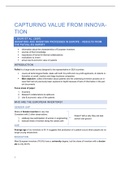Summary
Mandatory Literature Summary Capturing Value from Innovation (EBM738A05)
- Course
- Institution
All Mandatory Literature from the Course Catalogue 2021/22: Giuri,P. Mariani, M., Brusoni, S., Crespi, G., Francoz, D. Gambardella, A., Garcia-Fontes, W., Geuna, A., Gonzales, R. Harhoff, D., Hoisl, K., Le Bas, C., Luzzi, A., Magazzini, L. Nesta, L., Nomaler, Ö., Palomeras, N., Patel, P., Roma...
[Show more]



